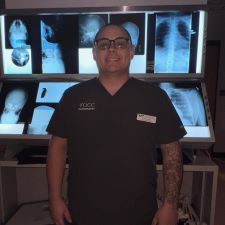Electronics Engineering Technology
Program Description
Think about the number of high-tech devices you own and use. Computers, cell phones, mp3 players, GPS devices, video game consoles, even the appliances in your kitchen have electronic components controlling them. Someone out there is designing these devices. Someone out there is repairing them. Someone out there is programming them. Someone out there is getting paid to do all these things. That someone could be you.
As important as electronic devices are to consumers, they’re especially so to companies. Businesses are looking for men and women who can troubleshoot and repair circuit boards. Manufacturers desperately need qualified technicians to keep automated machinery running. PLCs and robots rule many production floors, and companies need skilled people to design, program and install them. When you finish our program, you’ll leave confident, capable and competent.
The two-year EET degree program can train you in the ever growing electronics and computer field. A 18-credit-hour certificate program is also available. The demand is there. Employment is available. Choose now to complete your EET computer training at VGCC. EET includes training in both hardware and related software, emphasizing concepts to provide a unified view of computer-driven systems.
The Electronics Engineering Technology curriculum prepares individuals to become technicians who design, build, install, test, troubleshoot, repair, and modify developmental and production electronic components, equipment, and systems such as industrial/computer controls, manufacturing systems, communication systems, and power electronic systems.
A broad-based core of courses, including basic electricity, solid-state fundamentals, digital concepts, and microprocessors, ensures the student will develop the skills necessary to perform entry-level tasks. Emphasis is placed on developing the student’s ability to analyze and troubleshoot electronic systems.
Graduates should qualify for employment as engineering assistants or electronic technicians with job titles such as electronics engineering technician, field service technician, instrumentation technician, maintenance technician, electronic tester, electronic systems integrator, bench technician, and production control technician.
| Program Name | Credit Hours | Program Type |
|---|---|---|
| Electronics Engineering Technology A.A.S Degree A40200 (Course Sequence) | 68-69 | |
| Electronics Engineering Technology Certificate C40200C (Course Sequence) | 16 |
Program Details
Discover the specifics of our programs, including required courses, course sequence, pathways, and learning outcomes.
- Students will be able to use software to design, simulate, draw, and program electronic circuits and devices.
- Students will be able to apply circuit theorems, mathematical formulas, and logical operations to analyze circuit behavior.
- Students will understand basic electronic communication principles and concepts.
- Students will understand various computer systems and their constituent components.
- Students will understand the fundamentals of automation and control in an industrial environment.
- Students will understand the theory and operations of semiconductor devices and circuits.
- Students will be able to use tools and equipment properly and safely to analyze and troubleshoot circuits.
Students enrolled in pre-approved continuing education training courses may request awarded credit in corresponding curriculum programs. They must first register, pay, and pass the continuing education course with a grade of satisfactory. In order to request awarded credit, the student must be enrolled in the corresponding curriculum program.
The credit will be awarded by the appropriate department with a grade of “PR”, Credit for Prior Learning. The credit hours of the course will count toward graduation at VGCC but may not transfer to other colleges or universities.
For a more comprehensive list of Continuing Education courses and their corresponding curriculum programs, please visit Approved CE to CU Prior Learning Credits.
Approved Prior Learning Equivalencies
| CE Course Taken | Equivalent CU Course | Credit Hours Awarded | Effective Date |
|---|---|---|---|
| ELC 3014K Circuit Analysis I, 9.6 CEUs | ELC 131 Circuit Analysis I | 4 | January 1, 2016 |
| ELC 3014L Circuit Analysis II, 9.6 CEUs | ELC 133 Circuit Analysis II | 4 | January 1, 2016 |
| ELC 3014M Digital Electronics, 9.6 CEUs | ELN 133 Digital Electronics | 4 | January 1, 2016 |
| ELN 3025I Analog Electronics I, 9.6 CEUs | ELN 131 Analog Electronics I | 4 | January 1, 2016 |
| ISC 3036A Industrial Safety, 3.2 CEUs | ISC 112 Industrial Safety | 2 | January 1, 2016 |

“The Radiography program has taught me how to succeed in the program and how to provide great patient care. The teachers are a great help in getting you prepared.”

“Vance-Granville’s Radiography program is amazing. They truly care about developing the next generation of Radiologic Technologists. I couldn’t recommend it more to anyone who is curious about the field.”
